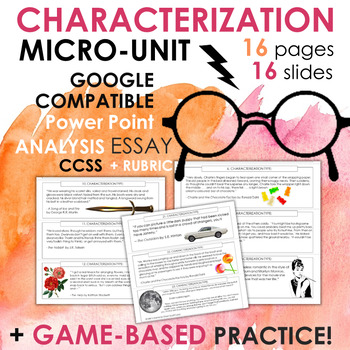Characterization Minilesson, GAME-BASED with Google Compatible PowerPoint, CCSS!
Dear Darling Teacher
421 Followers
Grade Levels
7th - 10th
Subjects
Resource Type
Standards
CCSSW.9-10.2a
CCSSW.9-10.2b
CCSSCCRA.R.1
CCSSCCRA.R.3
CCSSCCRA.R.6
Formats Included
- Zip
Pages
32 pages
Dear Darling Teacher
421 Followers
What educators are saying
This unit is very flexible and easy to use with students in various ways. Students enjoyed working in pairs to determine the type of characterization being described.
Description
This minilesson is perfect to couple with any unit or lesson focusing on characters! It includes everything you need, including a 16-page PowerPoint that can be uploaded to your Google Drive AND game-based practice. I have included character analysis essay instructions and rubric to take it one step further. This micro-unit focuses on indirect and direct characterization, as well as determining if a character is flat, round, dynamic, and/or static.
INCLUDES:
*Google-Compatible PowerPoint (just upload to your Drive and open in Slides)
*Character Analysis Essay Instructions and Rubric
*GAME-BASED Practice with instructions for 2 ways to play!
*2 characterization freebies:
-Characterization Bookmark
-Characterization Tracking Charts
Total Pages
32 pages
Answer Key
Included
Teaching Duration
N/A
Report this resource to TPT
Reported resources will be reviewed by our team. Report this resource to let us know if this resource violates TPT’s content guidelines.
Standards
to see state-specific standards (only available in the US).
CCSSW.9-10.2a
Introduce a topic; organize complex ideas, concepts, and information to make important connections and distinctions; include formatting (e.g., headings), graphics (e.g., figures, tables), and multimedia when useful to aiding comprehension.
CCSSW.9-10.2b
Develop the topic with well-chosen, relevant, and sufficient facts, extended definitions, concrete details, quotations, or other information and examples appropriate to the audience’s knowledge of the topic.
CCSSCCRA.R.1
Read closely to determine what the text says explicitly and to make logical inferences from it; cite specific textual evidence when writing or speaking to support conclusions drawn from the text.
CCSSCCRA.R.3
Analyze how and why individuals, events, and ideas develop and interact over the course of a text.
CCSSCCRA.R.6
Assess how point of view or purpose shapes the content and style of a text.





